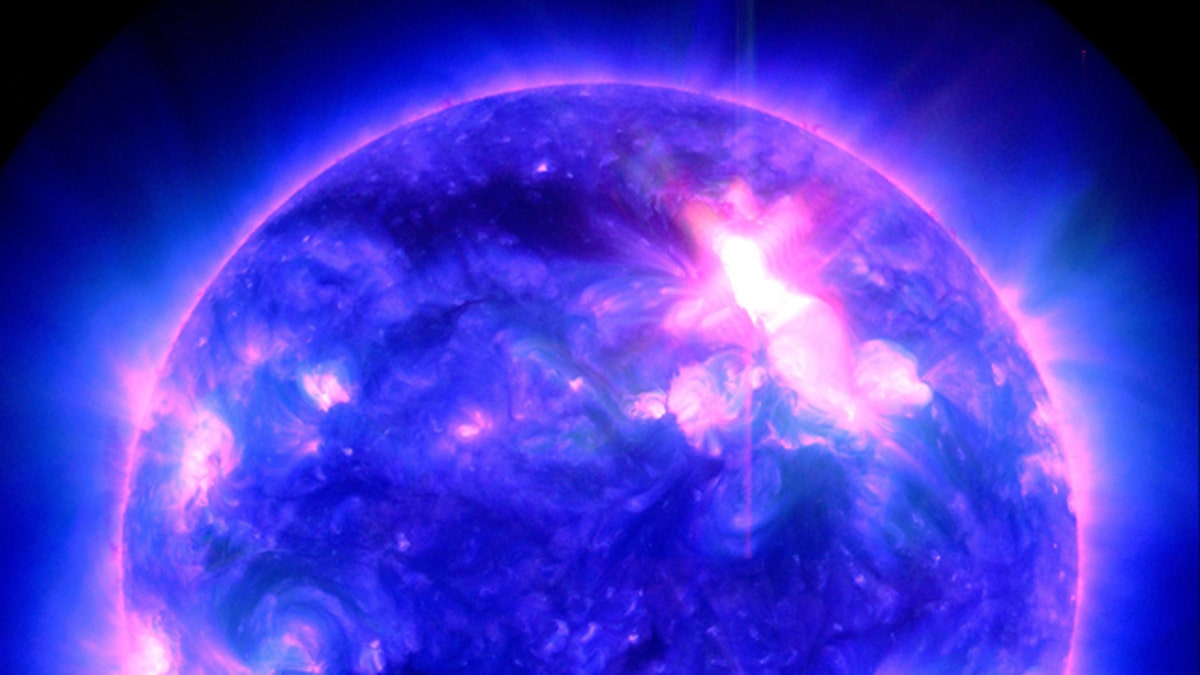
A powerful M9-class solar storm that unleashed a coronal mass ejection toward Earth in the early hours of Jan. 23, 2012 (GMT). (NASA/SDO/SOHO)
Radiation from an immense solar blast hit the Earth Tuesday -- forcing Delta Air Lines to redirect at least half a dozen airplanes that had been routed over the North Pole.
NOAA’s Space Weather Prediction Center -- the nation’s official source of warnings about space weather and its impact on Earth -- issued a geomagnetic storm warning Monday after a satellite witnessed an ultraviolet flash from the massive solar eruption.
There is no risk to people on Earth, Doug Biesecker of the NOAA Space Weather Prediction Center told FoxNews.com.
But as a rare precaution, some polar flights were re-routed to avoid communication lapses and exposing pilots and passengers to excessive radiation.
"We know that some airlines did not fly the polar routes yesterday," Biesecker told FoxNews.com. Delta is one of them, rerouting flights between Hong Kong and the U.S. that usually fly over the pole.
“We are adjusting the flight pattern of a few of our flights,” Anthony Black, a spokesman for Delta, told FoxNews.com. "We're flying further south than we would normally fly."
The changes -- mainly intended to prevent loss of radio communication -- affect approximately six flights today, he said; the airline will re-evaluate tomorrow to determine whether additional changes will be required.
Ed Martelle, a spokesman for American Airlines, said it was not affected by the solar flares, though American continued to monitor the situation. United did not respond to FoxNews.com emails, nor did the FAA respond to requests for more information.
Kathy Sullivan, deputy administrator of NOAA, first suggested that rerouting might be necessary Monday morning at a Meteorological Society meeting in New Orleans, La., according to Space.com.
Eruptions on the sun shoot tremendous streams of charged particles away from the star -- in this case directly towards us.
"A [coronal mass ejection (CME)] hit Earth's magnetic field on Jan. 24th at approximately 1500 UT (10 am EST). Geomagnetic storms are likely in the hours ahead. If it's dark where you live, go outside and look for auroras," Spaceweather.com wrote. Auroras were already clearly visible in the skies over Scotland and Northern England.
NASA and NOAA monitor for such events, as they could cause problems for astronauts, communications satellites, and even rocket launches.
It could also affect navigation and the power grid.
The solar flare spat out late Sunday, Jan. 22, at 10:59 p.m. EST was rated an M9-class eruption -- nearly an X-class flare, the most powerful type of solar storm.
NASA spokeswoman Kelly Humphries told Space.com the six spaceflyers currently living and working on the International Space Station are not in any danger.
"The flight surgeons have reviewed the space weather forecasts for the flare and determined that there are no expected adverse effects or actions required to protect the on-orbit crew," Humphries told SPACE.com in an email.
The flare led to the largest radiation storm of its kind since 2005 -- one still only described as a three on the scale of one to five, Biesecker told AFP.
NOAA measures geomagnetic storms on a five-point scale from 1 to 5. G1 storms are minor, leading to weak power grid fluctuations and having only minor impact on satellites. G5 storms are extreme, leading to widespread voltage control problems, damage to transformers, radio outages and satellite problems.
NOAA warned of geomagnetic storms on Tuesday as well -- another result of the flare. They may be as strong as G3, causing intermittent navigation issues and problems with low-Earth satellites.
The sun's activity waxes and wanes on an 11-year cycle, Space.com reported. Currently, activity in Solar Cycle 24 is expected to ramp up toward a "solar maximum" in 2013.
This still from a NASA space observatory video shows one view of a powerful, M9-class solar storm that unleashed a coronal mass ejection toward Earth in the early hours of Jan. 23, 2012 (GMT).
